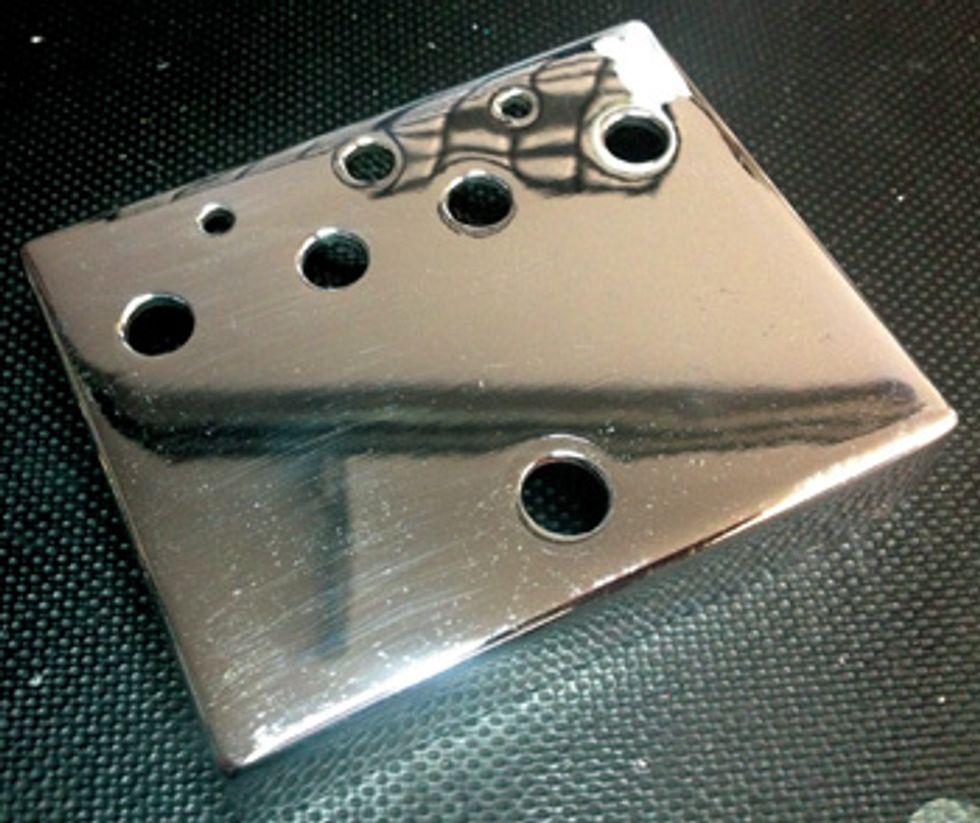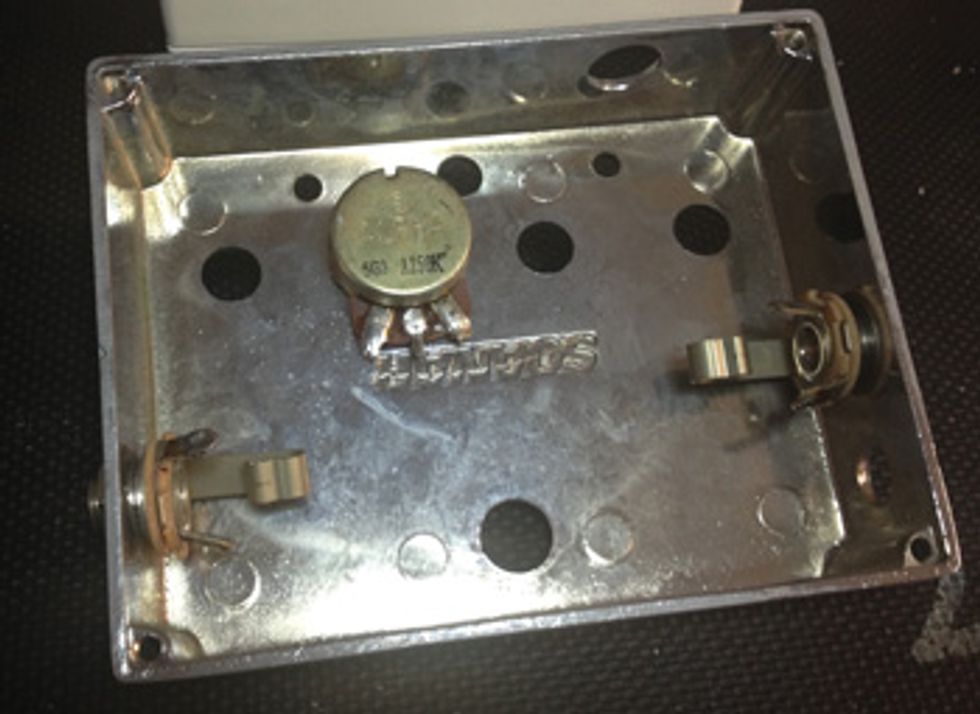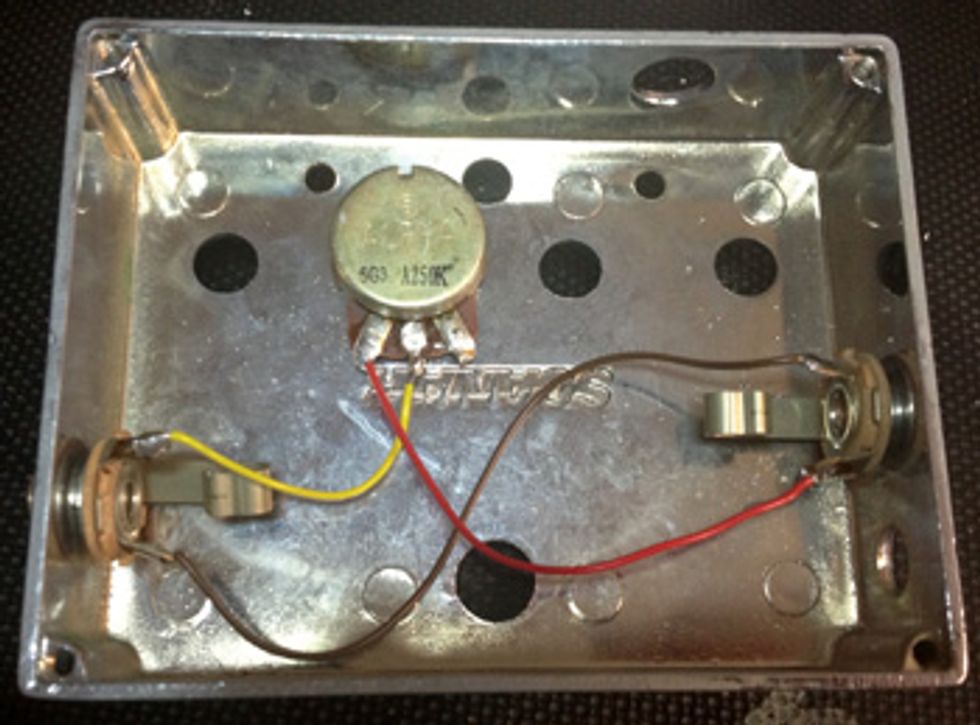Here’s a super-simple device that will let you coax new sounds from your fuzz pedal.

Fig. 1. You’ll need to drill three holes in your enclosure: two for the input and output jacks, and one for the potentiometer. Here I’ve used an old chrome Moon Phaser enclosure.

Fig. 2. The two jacks and the potentiometer mounted to the box.

Fig. 3. The simple wiring scheme looks like this: One wire from the ground (sleeve) tag of one of the jacks connects to the ground tag of the other jack. A second wire from the tip tag of one jack connects to the middle tag of the potentiometer. This becomes your input jack. A third wire from the tip tag of the output jack connects to the left tag of the potentiometer.

Fig. 4. Set up Tarquin between your guitar output and fuzz input.
Hello rock ’n’ rollers—greetings from the land of the long white cloud: Aotearoa (the Maori name for New Zealand). I decided to make this column a little more practical than some of my previous contributions (not that there’s anything wrong with existential musings on the nature of the volume knob). With that in mind, here’s a super-simple device that will let you coax new sounds from your fuzz pedal.
Let’s call this device “Tarquin.” Why? Simply because the name amuses me (no disrespect to readers who might happen to be named Tarquin). To build your own Tarquin, you’ll need a 250k A log potentiometer, two 1/4" jacks, a diecast enclosure, and three short wires. For tools, you’ll need a soldering iron, solder, and a drill to make holes in the enclosure for the potentiometer and jacks.
What exactly is Tarquin? If you put it in front of your fuzz pedal and adjust its dial, you increase the series resistance between your guitar pickup and the fuzz pedal’s input. This is different from your guitar’s volume control because Tarquin’s potentiometer does not connect to ground. Increasing the series resistance will reduce the pedal’s gain and also impact its tone and sustain. Tarquin opens up a bunch of options that were previously not there. A number of fuzz pedals offer this sort of control as part of their built-in interface. If your fuzz has “input,” “fuzz,” and “output” controls, it’s a safe bet that the input control is adjusting the input series resistance.
How do we bring Tarquin to life? The first step is to drill the die-cast enclosure you’re popping Tarquin into. You’ll need to drill two holes for the input and output jacks, as well as one on top (or wherever you like) to hold the potentiometer (Fig. 1). To provide ground shielding, make sure the enclosure has bare metal where the sockets and potentiometer are fitted.
Next you’ll need to attach the two jacks and potentiometer to the box (Fig. 2).
Now solder one wire from the ground (sleeve) tag of one of the jacks to the ground tag of the other jack. Solder another wire from the tip tag of one jack to the middle tag of the potentiometer. This becomes your input jack. Solder the third wire from the tip tag of the output jack to the left tag of the potentiometer. Refer to Fig. 3 for the potentiometer’s left/right orientation.
Finally, screw on the back of the device and then adorn it with suitable folk art, religious iconography, Victorian erotica, or whatever else you think might befit Tarquin.
Now to test: Plug your guitar into Tarquin’s input jack. Connect Tarquin’s output jack to your fuzz pedal input. Plug the output of your fuzz pedal into your amp. (See Fig. 4.) Play with Tarquin. Experiment with Tarquin. Love Tarquin.
Here’s the usual proviso: If you’re not comfy soldering, get someone who is to help out.
Until next time, champagne wishes and caviar dreams.
 Ben Fulton is a Libran. He likes long
walks on the beach and loves watching
the sun set. He likes going out dancing
but is just as happy to cuddle up in front
of the fire with a good movie and glass
of Pinot. He also is the CEO and head
designer at Red Witch Analog Pedals.
Ben Fulton is a Libran. He likes long
walks on the beach and loves watching
the sun set. He likes going out dancing
but is just as happy to cuddle up in front
of the fire with a good movie and glass
of Pinot. He also is the CEO and head
designer at Red Witch Analog Pedals.
